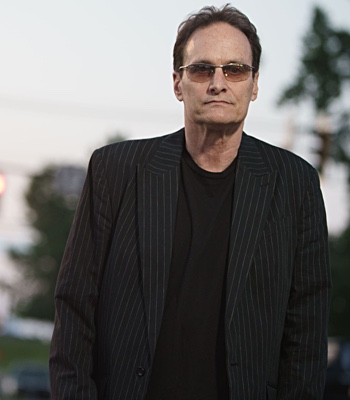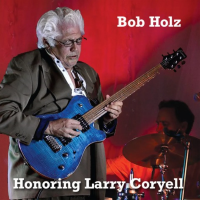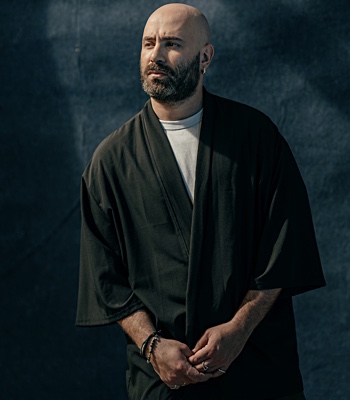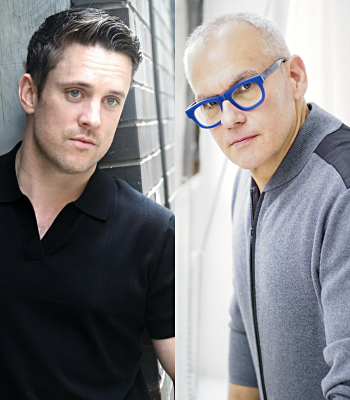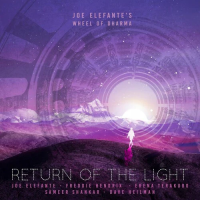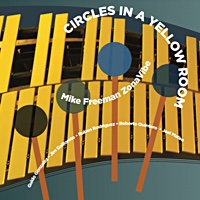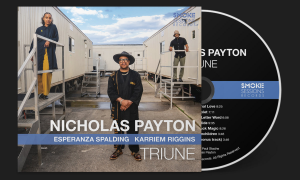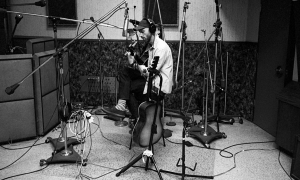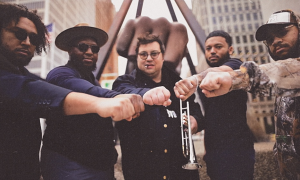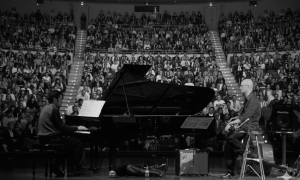By Something Else Reviews
News that Yes — the newest iteration, anyway—was in studio completing its first new recording in 10 years got us thinking about this shape-shifting progressive rock act.
Pity the poor soul trying to sort through anything beyond the obvious ("Roundabout," “And You and I," “Long Distance Runaround," “Owner of a Lonely Heart") with a band that has taken more twists and turns than the fantastical lettering created for its album covers by Roger Dean. (We count 9 keyboardists since Yes' 1968 founding, something that would give any drummer in Spinal Tap pause. How many times did Rick Wakeman quit? Four times? Five?)
Now featuring Steve Howe, Chris Squire and Alan White, along with Rick's son Oliver Wakeman on keyboards and Canadian singer Benoît David (who had been in a tribute band called Close to the Edge), Yes is again working with 90125-era producer Trevor Horn on an album that is reportedly slated for release “before summer 2011," according to its Web site.
Here's a quick look at a few recommended lesser-known tracks to get you ready. We'll start with another project that Howe, Squire and White recorded without longime original Yes vocalist Jon Anderson:
“DOES IT REALLY HAPPEN?" (DRAMA, 1980)
By Pico
One of these days, I'm going to write some valiant defense of the much-maligned Drama but for now, this will do. By 1980, Steve Howe, Chris Squire and Alan White had played together in the band for over seven years, practically a century in prog years. No longer having to compete against the likes of Jon Anderson and Rick Wakeman, both of whom left the band in the spring of that year, they really get their groove going.
On “Does It Really Happen?," Squire sets the tone with one of his song-defining bass lines, this time one that skitters between one bent note and one lower note played straight. White enters with an unexpected and persistent 2/4 beat, but it fits cleverly with Squire's irregular pattern. The groove is completed by Howe; he doesn't take any leads but his rhythm work features the usual pop. Little noticed is White's marimba work, since it's subtly rumbling underneath Geoffrey Downes' bank of keyboards, and in concert with Howe's comping guitar.
Squire also provides a rare lead vocal turn, and I can't understand his lyrics any better then Jon Anderson's, but that never mattered much on a Yes song, anyway. “Happen?" reaches an abrupt false ending around the five minute mark, only for the opening bass line and the rest of the band to reappear for about a minute and a half. This time, Squire ad libs playfully until the song fades out. With nary a trace of overindulgence and a very danceable beat, these serious musicians seemed to be having fun just mining a groove.
Can prog rock really be irresistibly funky? One band answered with an emphatic “Yes."
“SOUND CHASER," (RELAYER, 1974)
By Mark Saleski
The Relayer album brought keyboardist Patrick Moraz into the fold. You might think that after the reaction to Tales From Topographic Oceans, the band would be ready to return to shorter song structure. C'mon, this was 1974! Relayer spread three songs over two sides. Each song was its own mini-suite. This supposed lack of coherency drove the critics crazy. That seemed silly to me, especially if you go back and consider things like “Starship Trooper," so obviously constructed from three completely unrelated parts.
To my ears this is as close as Yes ever got to playing fusion. The tune starts with a shower of keyboard sparks before everybody hits a very percussive figure in unison, then a manic Chris Squire bass comment, a Moraz restatement, an Alan White drum solo, followed by a pause and then launch into the song proper. What follows is the Steve Howe show—crazed, tumbling guitar figures, a solo passage, and a short classical segment as well. Like much of the music on Relayer, “Sound Chaser" rocked a lot harder than anything on Tales. Maybe it was a reaction to that record's more ethereal nature, maybe it was the addition of Moraz on keys. Whatever the reason, this particular lineup was making some aggressive music. Aggressive, now there's a word you don't normally associate with this band.
“IT CAN HAPPEN" (90125, 1983)
By Nick DeRiso
You might have expected more from 90125, an early-1980s effort that found the band's rhythm section reuniting with vocalist Jon Anderson. Initial keyboardist Tony Kaye was back; even producer Trevor Horn was a former Yes-ster. But new guitarist Trevor Rabin was no Steve Howe. And Horn (what's with all these Trevors, anyway?) swaddled everything in a glitzy, then-current synth sound. Rather than reigniting Yes' seminal erudite groove, 90125 more often came off as glossed-over MTV-era replica, a signpost heralding the band's slow slide into prog rock-pop commercialism.
How crazy ironic is it that 90125, featuring so many Yes alums, sounded at times almost nothing like, you know, Yes? So, I go in wanting to dislike it. After all, I have the old albums. There's no Steve Howe, and all. Even so, this new amalgam sometimes clicked. I mean, the Fab Four-inspired “It Can Happen"—with its sparkling vocal interplay, the whack-job lyric and that nifty sitar riff—still makes my heart slosh in my chest. There remain elements of the core Yes sound: Anderson's vocal boasts all of his familiar quixotic splendor, then Chris Squire hits that trembling bass line. But there is a fresh modernity, too, as Rabin's backing vocal ("it's a constant fight") fragments into an element of the rhythm.
Yes could still, even in this polished new incarnation, be stubbornly romantic, a little hippified, a little weird. That's probably why “It Can Happen," released as the third single from 90125, didn't match the chart-topping success of “Owner of a Lonely Heart," only reaching No. 51 on the Billboard Hot 100 in 1984. But it's also a latter-period glimpse into why this group mattered all along.
“SOUTH SIDE OF THE SKY," (FRAGILE, 1971)
By Tom Johnson
It is a heady thing to behold, taking a chance. The leap from the only Yes I'd really known and cared about up to that point in my young life at 16 years old—glossy radio staples 90125 and Big Generator, essentially—to what I held in my hand at the record store was almost a complete mystery to me. Sure, there was the legend that haunted any mention of them in print, but what did it all mean? Words could only say so much, and in those times before samples of everything imaginable on Amazon and iTunes, it was down to luck to hear something other than a current or recent hit on the radio. Besides, radio. I'd practically given that up anyway, preferring instead this intoxicating thrill of the unknown, the luck of the draw, or, more accurately, gut feeling. My gut was telling me to get this weird old album adorned with some vaguely Earth-like, giant tree-covered planet and a bug-shaped ship crossing its surface. It was a heady thing to behold.
Fragile was such a weird little album. Forty one minutes that covered much of the territory most progressive rock bands were to ever touch upon and which, when you really cut it down to size, it really revealed itself as four true songs and some solo pieces, kind of the audio version of what Led Zeppelin would do with the film for The Song Remains The Same. Each a little vignette indulging every member's very own odd interests that nowhere else on a band's albums could be so easily displayed. Taken on a one by one basis, you only see facets, some odd, some fascinating, some beautiful. Coming back together for the songs, the real meat of the album, in between, the band delivers absolute gems. Gems of meat.
The amazing thing is that, even after nearly forty years, “South Side of the Sky" has remained a hidden, particularly meaty gem, eluding much attention outside of fan circles despite being one of the band's heavier, more frantic songs that still somehow managed to be entirely melodic. Here we see glimpses of the future, maybe a bit of what was to come in a couple years with Relayer's angular obtuseness. Steve Howe's trademark twang takes on an aggressive quack, at times manically stair-stepping over Chris Squire's gurgling bass line. Listen closely: Bill Bruford is mesmerizing behind the drums. It seems simple but it gathers steam as the song wears on, packing in more twists and turns than seems necessary and yet seems perfectly sensible. Rick Wakeman compliments all of this with organ and, in the breakdown, a beautifully elegant piano line that seems like it's something I know from somewhere else and yet it's not. On top of it all, Jon Anderson's airy vocals narrate a polar expedition gone tragically wrong—one of the more straight forward lyrics in early Yes material, actually. It's all perfectly dialed in, every member adding just the right touch to his part, never too little, never too much. It's one of those songs you could play for those anti-Yes and you might make some headway with them
At sixteen, however, I didn't catch much of this. It sped by in a blur as an album of high points and weird, offshoot out-there skits ... and, despite the reigning status as “hits" of “Roundabout" and “Heart of the Sunshine," or even “Long Distance Runaround," it has always been “South Side of the Sky" which, in a pinch, given only a small window to listen to Yes, I will turn to. It's a heady thing, see.
News that Yes — the newest iteration, anyway—was in studio completing its first new recording in 10 years got us thinking about this shape-shifting progressive rock act.
Pity the poor soul trying to sort through anything beyond the obvious ("Roundabout," “And You and I," “Long Distance Runaround," “Owner of a Lonely Heart") with a band that has taken more twists and turns than the fantastical lettering created for its album covers by Roger Dean. (We count 9 keyboardists since Yes' 1968 founding, something that would give any drummer in Spinal Tap pause. How many times did Rick Wakeman quit? Four times? Five?)
Now featuring Steve Howe, Chris Squire and Alan White, along with Rick's son Oliver Wakeman on keyboards and Canadian singer Benoît David (who had been in a tribute band called Close to the Edge), Yes is again working with 90125-era producer Trevor Horn on an album that is reportedly slated for release “before summer 2011," according to its Web site.
Here's a quick look at a few recommended lesser-known tracks to get you ready. We'll start with another project that Howe, Squire and White recorded without longime original Yes vocalist Jon Anderson:
“DOES IT REALLY HAPPEN?" (DRAMA, 1980)
By Pico
One of these days, I'm going to write some valiant defense of the much-maligned Drama but for now, this will do. By 1980, Steve Howe, Chris Squire and Alan White had played together in the band for over seven years, practically a century in prog years. No longer having to compete against the likes of Jon Anderson and Rick Wakeman, both of whom left the band in the spring of that year, they really get their groove going.
On “Does It Really Happen?," Squire sets the tone with one of his song-defining bass lines, this time one that skitters between one bent note and one lower note played straight. White enters with an unexpected and persistent 2/4 beat, but it fits cleverly with Squire's irregular pattern. The groove is completed by Howe; he doesn't take any leads but his rhythm work features the usual pop. Little noticed is White's marimba work, since it's subtly rumbling underneath Geoffrey Downes' bank of keyboards, and in concert with Howe's comping guitar.
Squire also provides a rare lead vocal turn, and I can't understand his lyrics any better then Jon Anderson's, but that never mattered much on a Yes song, anyway. “Happen?" reaches an abrupt false ending around the five minute mark, only for the opening bass line and the rest of the band to reappear for about a minute and a half. This time, Squire ad libs playfully until the song fades out. With nary a trace of overindulgence and a very danceable beat, these serious musicians seemed to be having fun just mining a groove.
Can prog rock really be irresistibly funky? One band answered with an emphatic “Yes."
“SOUND CHASER," (RELAYER, 1974)
By Mark Saleski
The Relayer album brought keyboardist Patrick Moraz into the fold. You might think that after the reaction to Tales From Topographic Oceans, the band would be ready to return to shorter song structure. C'mon, this was 1974! Relayer spread three songs over two sides. Each song was its own mini-suite. This supposed lack of coherency drove the critics crazy. That seemed silly to me, especially if you go back and consider things like “Starship Trooper," so obviously constructed from three completely unrelated parts.
To my ears this is as close as Yes ever got to playing fusion. The tune starts with a shower of keyboard sparks before everybody hits a very percussive figure in unison, then a manic Chris Squire bass comment, a Moraz restatement, an Alan White drum solo, followed by a pause and then launch into the song proper. What follows is the Steve Howe show—crazed, tumbling guitar figures, a solo passage, and a short classical segment as well. Like much of the music on Relayer, “Sound Chaser" rocked a lot harder than anything on Tales. Maybe it was a reaction to that record's more ethereal nature, maybe it was the addition of Moraz on keys. Whatever the reason, this particular lineup was making some aggressive music. Aggressive, now there's a word you don't normally associate with this band.
“IT CAN HAPPEN" (90125, 1983)
By Nick DeRiso
You might have expected more from 90125, an early-1980s effort that found the band's rhythm section reuniting with vocalist Jon Anderson. Initial keyboardist Tony Kaye was back; even producer Trevor Horn was a former Yes-ster. But new guitarist Trevor Rabin was no Steve Howe. And Horn (what's with all these Trevors, anyway?) swaddled everything in a glitzy, then-current synth sound. Rather than reigniting Yes' seminal erudite groove, 90125 more often came off as glossed-over MTV-era replica, a signpost heralding the band's slow slide into prog rock-pop commercialism.
How crazy ironic is it that 90125, featuring so many Yes alums, sounded at times almost nothing like, you know, Yes? So, I go in wanting to dislike it. After all, I have the old albums. There's no Steve Howe, and all. Even so, this new amalgam sometimes clicked. I mean, the Fab Four-inspired “It Can Happen"—with its sparkling vocal interplay, the whack-job lyric and that nifty sitar riff—still makes my heart slosh in my chest. There remain elements of the core Yes sound: Anderson's vocal boasts all of his familiar quixotic splendor, then Chris Squire hits that trembling bass line. But there is a fresh modernity, too, as Rabin's backing vocal ("it's a constant fight") fragments into an element of the rhythm.
Yes could still, even in this polished new incarnation, be stubbornly romantic, a little hippified, a little weird. That's probably why “It Can Happen," released as the third single from 90125, didn't match the chart-topping success of “Owner of a Lonely Heart," only reaching No. 51 on the Billboard Hot 100 in 1984. But it's also a latter-period glimpse into why this group mattered all along.
“SOUTH SIDE OF THE SKY," (FRAGILE, 1971)
By Tom Johnson
It is a heady thing to behold, taking a chance. The leap from the only Yes I'd really known and cared about up to that point in my young life at 16 years old—glossy radio staples 90125 and Big Generator, essentially—to what I held in my hand at the record store was almost a complete mystery to me. Sure, there was the legend that haunted any mention of them in print, but what did it all mean? Words could only say so much, and in those times before samples of everything imaginable on Amazon and iTunes, it was down to luck to hear something other than a current or recent hit on the radio. Besides, radio. I'd practically given that up anyway, preferring instead this intoxicating thrill of the unknown, the luck of the draw, or, more accurately, gut feeling. My gut was telling me to get this weird old album adorned with some vaguely Earth-like, giant tree-covered planet and a bug-shaped ship crossing its surface. It was a heady thing to behold.
Fragile was such a weird little album. Forty one minutes that covered much of the territory most progressive rock bands were to ever touch upon and which, when you really cut it down to size, it really revealed itself as four true songs and some solo pieces, kind of the audio version of what Led Zeppelin would do with the film for The Song Remains The Same. Each a little vignette indulging every member's very own odd interests that nowhere else on a band's albums could be so easily displayed. Taken on a one by one basis, you only see facets, some odd, some fascinating, some beautiful. Coming back together for the songs, the real meat of the album, in between, the band delivers absolute gems. Gems of meat.
The amazing thing is that, even after nearly forty years, “South Side of the Sky" has remained a hidden, particularly meaty gem, eluding much attention outside of fan circles despite being one of the band's heavier, more frantic songs that still somehow managed to be entirely melodic. Here we see glimpses of the future, maybe a bit of what was to come in a couple years with Relayer's angular obtuseness. Steve Howe's trademark twang takes on an aggressive quack, at times manically stair-stepping over Chris Squire's gurgling bass line. Listen closely: Bill Bruford is mesmerizing behind the drums. It seems simple but it gathers steam as the song wears on, packing in more twists and turns than seems necessary and yet seems perfectly sensible. Rick Wakeman compliments all of this with organ and, in the breakdown, a beautifully elegant piano line that seems like it's something I know from somewhere else and yet it's not. On top of it all, Jon Anderson's airy vocals narrate a polar expedition gone tragically wrong—one of the more straight forward lyrics in early Yes material, actually. It's all perfectly dialed in, every member adding just the right touch to his part, never too little, never too much. It's one of those songs you could play for those anti-Yes and you might make some headway with them
At sixteen, however, I didn't catch much of this. It sped by in a blur as an album of high points and weird, offshoot out-there skits ... and, despite the reigning status as “hits" of “Roundabout" and “Heart of the Sunshine," or even “Long Distance Runaround," it has always been “South Side of the Sky" which, in a pinch, given only a small window to listen to Yes, I will turn to. It's a heady thing, see.

